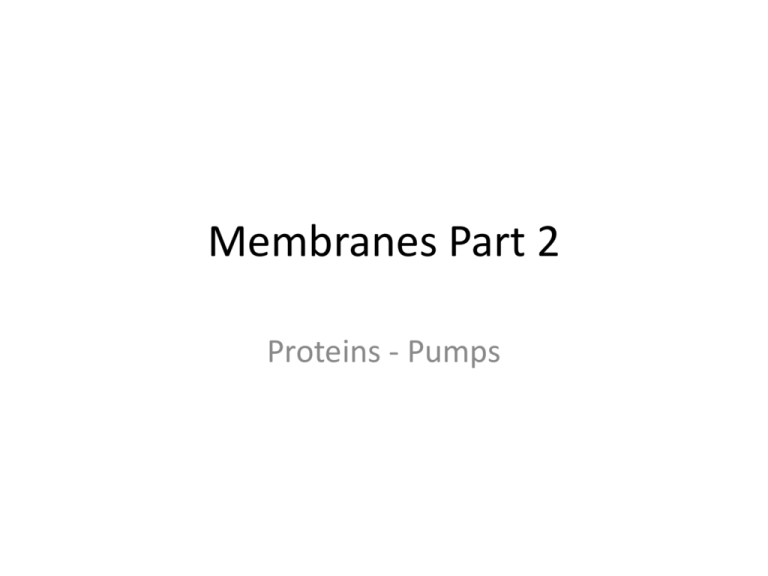
Membranes Part 2
Proteins - Pumps
Membrane Proteins
• Integral proteins
– Transmembrane
domains
• 25 aa -helix
• -barrel
• H-bonding of all amino &
carbonyl groups
• Hydrophobic residues
– G, A, L, I, V
– Hydropathy calculations
predict TM domains
from protein sequence
Membrane Proteins
• Peripheral proteins
– Acylation
• Farnesylation
• Myristoylation
• Palmitoylation
–
–
–
–
GPI anchor
Electrostatic interaction
Partial insertion
Association with integral protein
Transport Complexes
Control of Membrane Permeability
• Selective permeability of membranes
• Control of solute movement across membranes
– Pumps
• "active transport"
• Require energy source to achieve movement
– Carriers
• "passive transport"
• Movement of particles down concentration gradients result in
conformational changes that can allow transport against gradient
– Channels
• "selective passive transport"
• Opening and closing is regulated
Types of Membrane Pumps
Energy Source
Pump
Bacteriorhodopsin
Substance Distribution
H+
Halobacteria
Halorhodopsin
Cl-
Photoredox
H+
Photosynthetic
organisms
Redox potential
Electron transport
chain NADH oxidase
H+
Mitochondria,
bacteria
Decarboxlyation
Ion-transporting
decarboxlyases
Na+
Bacteria
Pyrophosphate
H+-pyrophosphatase
H+
Plant vacuoles, fungi,
bacteria
ATP
Transport ATPases
Light
various
ions
Universal
Three Families of Transport ATPases
Class
Distribution
Substrate
Functions
F-type
Bacteria, chloroplast
H+
ATP synthesis or
ATP driven H+ pumping
mitochondria
V-type
Archaea, eukaryotic
H+
ATP driven H+ pumping
membranes
P-type
Plasma memb, ER
Na, K, Ca
Cation pumping
ABC
Plasma membrane
Various
Solute transport
Copyright 2008 by Saunders/Elsevier. All rights reserved.
Three Families of Transport ATPases
F-type ATPase
P-type ATPase
ABC transporter
Figs. 8-5, 8-7, 8-9
Copyright 2008 by Saunders/Elsevier. All rights reserved.
ATP-DrivenSubstrate
Pumps1 Function
Pump
Distribution
F0F1
Mitochondria, chloroplasts,
bacteria, plasma membranes
H+
ATP synthesis
V0V1
eukaryotic endomembranes
H+
ATP-driven H+ pumping
Na/K-ATPase
plasma membrane
3 Na+ for 2 K+
Na/K gradient generation
H/K – ATPase
stomach & kidney cell plasma
membranes
1 H+ for 1 K+
gastric & renal H secretion
H-ATPase
plasma membrane in yeast,
plants & protozoa
1 H+
proton gradient
CFTR
respiratory & pancreatic
epithelial cell plasma
membranes
ATP, Cl-
Cl- secretion
MDR1
Plasma membrane
Drugs
MDR2
Liver apical membrane
PC
Flippase, bile secretion
F and V family ATPases
Subcellular Distribution of F-type and V-type ATPases
Copyright 2008 by Saunders/Elsevier. All rights reserved.
Fig. 1.2
P-type ATPase: Ca2+ of the endoplasmic reticulum
Fig. 8-7
Copyright 2008 by Saunders/Elsevier. All rights reserved.
Mechanism of the P-type Ca-pump
Copyright 2008 by Saunders/Elsevier. All rights reserved.
Fig. 8-8
ABC Transporters
Pump
Distribution
Substrate
Functions
MDR1
Plasma membrane
Organics, drugs
Drug secretion
MDR2
Liver plasma membrane
Phosphatidylcholine
Flippase
CFTR
Respiratory, pancreas PM
ATP, Cl-
Cl- secretion
TAP1, 2
ER
Antigenic peptides
ER/cytoplasm transport
HisQMP
Bacterial PM
Histidine
Histidine uptake
PstSCAB
Bacterial PM
Phosphate
Phosphate uptake
OppDFBCA
Bacterial PM
Oligopeptides
Peptide uptake
Copyright 2008 by Saunders/Elsevier. All rights reserved.
ABCs of ABC Transporters
• ATP Binding Cassette
• Walker A motif or P-loop
– GXXGXGKS/T
– Binds g PO4
• Walker B motif
– GX6-8F4D
– Binds Mg2+
ABC transporters: variations on a common theme
Vitamin B12
transporter
BtuC BtuD
Figs. 8-9 and 8-10
Copyright 2008 by Saunders/Elsevier. All rights reserved.
Crystal structure & proposed mechanism of the BtuCD
vitamin B12 ABC transporter
Fig. 8-10
Copyright 2008 by Saunders/Elsevier. All rights reserved.
Multiple drug resistance of human tumors from over
expression of MDR ABC transporter
Fig. 8-11
Copyright 2008 by Saunders/Elsevier. All rights reserved.







